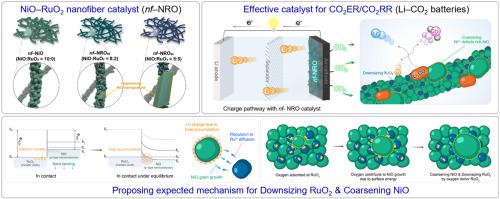Ni–deficient NiO/downsized RuO2 composite catalyst with rivalrous size evolution for rechargeable Li–CO2 batteries
IF 14.2
1区 材料科学
Q1 ENGINEERING, MULTIDISCIPLINARY
引用次数: 0
Abstract
Lithium–carbon dioxide (Li–CO2) batteries utilize a lightweight and environmentally impactful CO2 gas as a cathode and offer a high energy density (1876 Wh kg−1). However, the thermodynamically stable discharge product, Li2CO3, necessitates the use of catalysts to facilitate reversible reaction kinetics, underscoring the importance of developing efficient catalysts to overcome this bottleneck. In this study, we fabricate nanofiber NiO–RuO2 composite oxide catalysts (nf–NRO) to utilize the synergistic effect of the two oxides. In particular, we spotlight a critical phenomenon–rivalrous grain growth between two oxide components–as a strategy for catalyst optimization, balancing cost–effectiveness and catalytic performance. We observe rivalrous particle size changing behavior, where increasing the RuO2 ratio in the composite oxide leads to RuO2 downsizing and NiO coarsening. To elucidate this phenomenon, we propose expected mechanisms supported by DFT calculations; 1) Band bending between metallic oxide and p–type semiconductor, 2) Interfacial redox reactions driven by differences in the reduction potentials of the NiO and RuO2 nanoparticles, 3) Acceleration of NiO growth due to the oxygen donor effect of RuO2 coupled with surface energy–driven growth mechanisms. Accordingly, the catalytic property of nf–NRO55 is maximized by downsizing RuO2 and Ni3+–rich NiO. The Li–CO2 battery with nf–NRO exhibits lower charge platform and superior cycle stability over 120 cycles. As a result, the correlation between the material properties of the nf–NRO and their electrochemical performance is identified.

可充电锂-二氧化碳电池用缺镍NiO/缩小尺寸RuO2复合催化剂
锂-二氧化碳(Li-CO2)电池利用轻质且环保的二氧化碳气体作为阴极,并提供高能量密度(1876 Wh kg - 1)。然而,热力学稳定的放电产物Li2CO3需要使用催化剂来促进可逆反应动力学,这突出了开发高效催化剂以克服这一瓶颈的重要性。在本研究中,我们制备了纳米纤维NiO-RuO2复合氧化物催化剂(nf-NRO),以利用两种氧化物的协同效应。我们特别关注了一个关键现象——两种氧化物组分之间的竞争性晶粒生长——作为催化剂优化、平衡成本效益和催化性能的策略。我们观察到竞争粒度的变化行为,其中增加复合氧化物中RuO2的比例导致RuO2缩小和NiO粗化。为了阐明这一现象,我们提出了由DFT计算支持的预期机制;1)金属氧化物与p型半导体之间的能带弯曲;2)NiO和RuO2纳米颗粒的还原电位差异驱动的界面氧化还原反应;3)RuO2的氧供体效应与表面能驱动的生长机制耦合导致NiO的加速生长。因此,通过减小RuO2和富Ni3+ NiO的体积,可以最大限度地提高nf-NRO55的催化性能。具有nro的锂-二氧化碳电池具有较低的充电平台和超过120次循环的优异循环稳定性。结果表明,nro的材料性能与其电化学性能之间存在相关性。
本文章由计算机程序翻译,如有差异,请以英文原文为准。
求助全文
约1分钟内获得全文
求助全文
来源期刊

Composites Part B: Engineering
工程技术-材料科学:复合
CiteScore
24.40
自引率
11.50%
发文量
784
审稿时长
21 days
期刊介绍:
Composites Part B: Engineering is a journal that publishes impactful research of high quality on composite materials. This research is supported by fundamental mechanics and materials science and engineering approaches. The targeted research can cover a wide range of length scales, ranging from nano to micro and meso, and even to the full product and structure level. The journal specifically focuses on engineering applications that involve high performance composites. These applications can range from low volume and high cost to high volume and low cost composite development.
The main goal of the journal is to provide a platform for the prompt publication of original and high quality research. The emphasis is on design, development, modeling, validation, and manufacturing of engineering details and concepts. The journal welcomes both basic research papers and proposals for review articles. Authors are encouraged to address challenges across various application areas. These areas include, but are not limited to, aerospace, automotive, and other surface transportation. The journal also covers energy-related applications, with a focus on renewable energy. Other application areas include infrastructure, off-shore and maritime projects, health care technology, and recreational products.
 求助内容:
求助内容: 应助结果提醒方式:
应助结果提醒方式:


